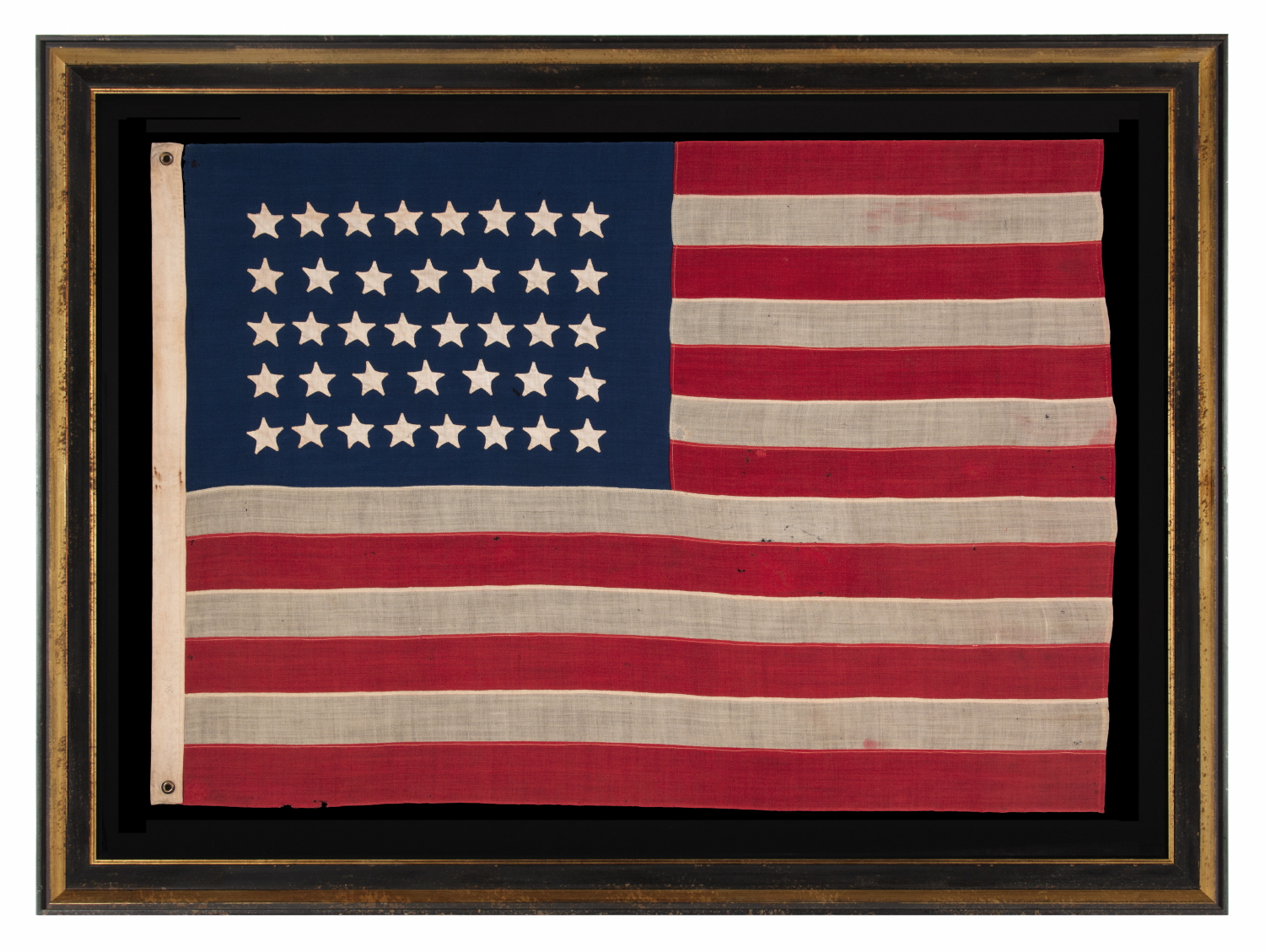
| |
38 HAND-SEWN STARS IN AN UNUSUALLY CONFINED PATTERN OF JUSTIFIED ROWS, ON AN ANTIQUE FLAG IN AN ESPECIALLY SMALL SCALE FOR THE PERIOD, 1876-1889, COLORADO STATEHOOD |
|
| Available: |
Sold |
| Frame Size (H x L): |
Approx. 48" x 65" |
| Flag Size (H x L): |
36.25" x 53" |
|
| Description....: |
|
38 star American national flag in an especially small scale among its 19th century counterparts with pieced-and-sewn construction. The stars are made of cotton, hand-sewn, and double-appliqued (applied to both sides). These are arranged in justified lineal rows in counts of 8-7-8-7-8. All of the stars are oriented in an upright position (with one point up), but what's unusual about them is the amount of blue canton that surrounds them. Note how the stars are corralled in a tight regiment within the center of the union. Also note that their tips are slightly flattened, which lends an attractive appearance. I have previously owned two flags by the same, unidentified maker, in the same design. The others were slightly larger, measuring approximately 4 feet on the hoist instead of 3 feet, like this example.
The stripes and canton are made of wool bunting that has been pieced with treadle stitching. This is typical of the period. There is twill cotton binding along the hoist with two brass grommets.
Colorado became the 38th state on August 1st, 1876. This was the year of our nation’s 100-year anniversary of independence. Per the Third Flag Act of 1818, stars were not officially added until the 4th of July following a state's addition. For this reason, 37 was the official star count for the American flag in 1876. Flag-making was a competitive venture, however, and few flag-makers would have been continuing to produce 37 star flags when their competitors were making 38’s. It is for this reason that 38 and 13 stars (to represent the original 13 colonies) are more often seen at the Centennial International Exposition, the six-month long World’s Fair held in Philadelphia in honor of the event. Some flag-makers would have been adding a star for the 38th state even before it entered the Union, in the early part of 1876 or even prior. In fact, many makers of printed parade flags were actually producing 39 star flags, in hopeful anticipation of the addition of two more Western Territories instead of one. The 39th state would not join the Union for another 13 years, however, when the Dakota Territory entered as two states on the same day. The 38 star flag became official on July 4th, 1877 and was generally used until the addition of the Dakotas in 1889.
President Ulysses S. Grant was in office when the first 38 star flags would have appeared. The list of presidents serving during the period when the 38 star flag was actually official include Rutherford B. Hayes, James Garfield, Chester Arthur, Grover Cleveland, and Benjamin Harrison.
During the 19th century, flags with pieced-and-sewn construction (as opposed to printed) were typically eight feet long or larger. This is because they were important in their function as signals, meaning that they needed to be seen and recognized from a great distance. Even flags made for decorative purpose were generally very large by today’s standards. A small flag was six feet in length. Smaller flags, such as this one, were even more unusual. Since the average 19th century sewn flag can be cumbersome to frame and display in an indoor setting, many collectors prefer printed parade flags and smaller sewn flags, like this one, the size of which provides a good balance between visual impact and versatility.
Mounting: The flag was stitched to 100% silk organza on every seam and throughout the star field for support. It was then sewn to a background of 100% cotton twill, black in color, which was washed to remove excess dye. An acid-free agent was added to the wash to further set the dye and the fabric was heat-treated for the same purpose. The mount was then placed in a black-painted, hand-gilded and distressed Italian molding. The glazing is U.V. protective Plexiglas.
Condition: There is extremely minor mothing. There is minor to modest bleeding of the red dye in limited areas. There is a very small hole in the 3rd white stripe, adjacent to the canton. Period fabric of similar coloration was placed behind this area for masking purposes. There is a very small darning repair in the 4th red stripe, near the canton, and there is some foxing and staining along the hoist binding and in the stars. The length of the flag was shortened at some point, most certainly for the purposes of repairing losses from wind shear. This is evidenced by the fact that the fly end has been turned back and re-bound, as a proper and ordinary means of extending its period of use. Many of my clients prefer early flags to show their age. |
|
|
|
| Collector Level: |
Intermediate-Level Collectors and Special Gifts |
|
| Flag Type: |
Sewn flag |
|
| Star Count: |
38 |
|
| Earliest Date of Origin: |
1876 |
|
| Latest Date of Origin: |
1889 |
|
| State/Affiliation: |
Colorado |
|
| War Association: |
1866-1890 Indian Wars |
|
| Price: |
SOLD |
|
| |
Views: 1311 |
|
|
|

